06 - Constraint Difference Report
Overview
Design differences include connectivity (logical), implementation (physical), and constraint changes.
Cadence Constraints Differencing Utility compares two databases and reports the differences in constraint values. The following types of databases can be compared using this utility:
- Schematic database (*.cpm)
- Layout database (*.brd, *.sip, *.mcm)
- Constraints Manager database (*.dcf, *.tcf)
You can run this utility anytime during the design flow and see the differences in constraints between two databases before proceeding further.
To invoke the utility, run cmDiffUtility command from the command prompt. This command opens the Cadence Constraints Differencing Utility dialog box.
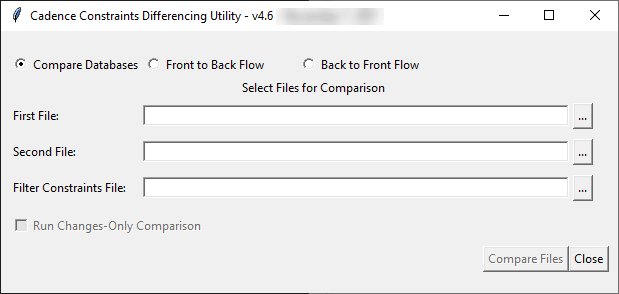
On selecting schematic database created in Allegro System Architect, the utility always run in Compare Databases mode. The schematic databases are only compared and constraints difference report is generated.
Filter Constraints File
To control the display of constraint information in the report, choose a filter file. A filter file is a text file that contains the names of properties that you define either to display or to ignore from the difference report. The name of properties must be the same as specified in Constraint Manager dictionary.
You can specify the filter files in two ways:
- Blacklist file: This file contains a list of properties that are not included in the difference report. The file is considered as blacklist if the first line of a file is set as !blacklist.
-
Whitelist file: This file contains a list of properties that are required to be included in the difference report. The file is considered as whitelist if the first line of a file is set as !whitelist.
If not specified, the filter file is set as a whitelist filter file. In case more than one values are set, the last one is considered.
Sample Filter File
The following is an example of a blacklist file:
!blacklist STUB_LENGTHFor adding comments in the filter file using the # symbol.
Using a filter file may hide an important information. Use the filter file only when two databases are compared. Avoid using filter file during the front-to-back or back-to-front flow.
You can either navigate to the filter file location, or it will automatically appear if any of the following (options) are set:
- The
CM_DIFF_UTILITY_PROP_FILTER_FILEenvironment variable with the name and path of filter file. - The
CM_DIFF_UTILITY_PROP_FILTER_FILEenvironment variable with the name of filter file. The file will be searched at the following locations:- $HOME/cdssetup
- $CDS_SITE/cdssetup
- The propFilter.txt exists at the following locations:
- $HOME/cdssetup
- $CDS_SITE/cdssetup
- The
.cpmdirectiveCM_DIFF_UTILITY_PROP_FILTER_FILECPM directive is set in the CONSTRAINT_MANAGER section of the .cpmfile.
You can define this directive either at site level or project level.
Changes-only comparison
When a schematic database is compared with a layout database and the Run Changes-Only Comparison option is enabled, the comparison is performed in changes-only mode to verify the front-to-back or back-to-front flow and a report is generated.
With the changes-only mode, the constraint value is preserved if it is changed by the user in the destination database after the last flow.
Generating Constraint Difference Report
To compare the constraints, complete the following steps:
- Run the mDiffUtility command from the command prompt.
The Cadence Constraints Differencing Utility dialog box is displayed. - Choose First File. Browse to select the first database.
- Choose Second File. Browse to select the second database.
- Optionally, select a Filter Constraint File.
- Optionally, select Run Changes-Only Comparison if a logical database is compared with a physical database.
- Click Compare Files.
A report is generated as a result of comparison.
Comparing The Same Databases
- Schematic: Compares two different versions of the same schematic database.
- Layout: Compares two different versions of the same layout database.
Valid file types are:
- Constraints Files: *.dcfx, *.dcf, *.tcfx, *.tcf
- Design Files: *.brd, *.sip, *.mcm
- Schematic Projects: *.cpm
Comparing Schematic Versus Layout Databases
- Front to back flow: Compares the schematic database with the layout database. Valid files are: *.cpm, *.brd, *.sip, and *.mcm.
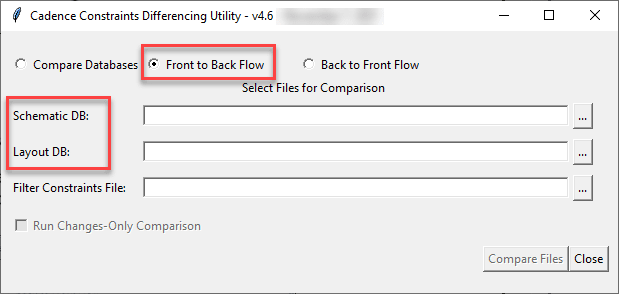
- Back to front flow: Compares the layout database with the schematic database. Valid files are:
*.cpm,*.brd,*.sip, and*.mcm.
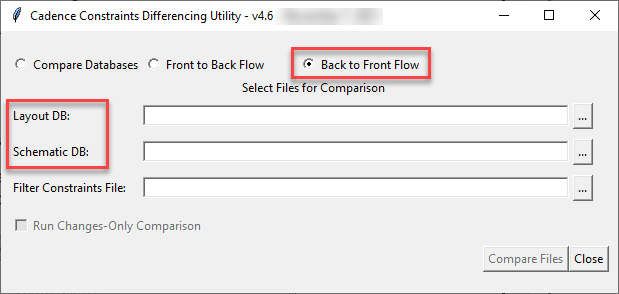
Comparing Constraints in Technology File
You can compare constraint values in technology files in PCB Editor.
To generate the constraint differences, complete the following steps:
- Choose File – Import – Constraints or File – Import – Technology file.
The Import Constraints or Import a technology file dialog box is displayed. - Select the Report Only check-box for generating the constraint difference report.
- Choose a .dcf/.tcf file to compare.
A progress bar is displayed during report generation. When the process completes, the Constraints Difference Report is displayed.
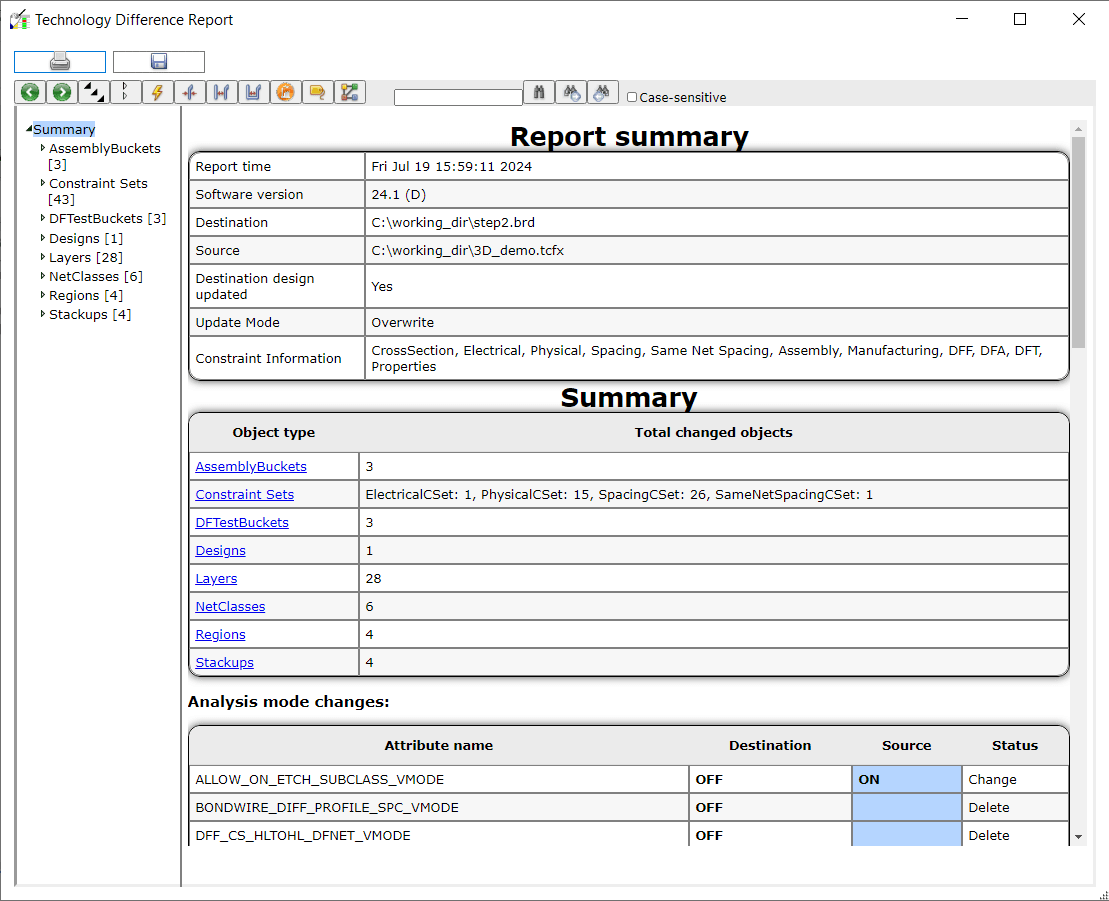
Constraint Difference Report Viewer
The report is displayed in a built-in report viewer.
The report viewer supports a clean, intuitive graphical user interface for displaying constraint differences between the two databases.This viewer consists of a toolbar, and view window.
Report Viewer Toolbar
The following figure displays the report viewer toolbars.

The following table describes the function of each button:
Constraint Difference Report: Toolbar Description
| Name | Icon | Function |
|---|---|---|
|
Previous Selection |
|
Shows the previous view of the report |
|
Next Selection |
|
Shows the next view of the report |
|
Export report to HTML |
|
Exports the report as an HTML page |
|
Print Preview |
|
Shows a printer-friendly view of the report |
|
Expand all |
|
Expands all the rows and columns |
|
Collapse all |
|
Collapses all the rows and columns |
|
Toggle Electrical constraint changes |
|
Displays only those ECSets for which there is a change in the constraint values. |
|
Toggle Physical constraint changes |
|
Displays only those PCSets for which there is change in constraint values. |
|
Toggle Spacing constraint changes |
|
Displays only those SCSets for which there is change in constraint values. |
|
Toggle Same Net Spacing constraint changes |
|
Displays only those Same Net SCSets for which there is change in constraint values. |
|
Toggle Design For Fabrication changes |
|
Displays only those Design for Fabrication CSets for which there is change in constraint values. |
|
Toggle Property changes |
|
Displays only those properties for which there is change in constraint value. |
|
Toggle Structural changes |
|
Displays only those grouping objects (differential pairs, match groups, net groups, and so on) for which there are changes in the constraint value. |
|
Find |
|
Displays the search result by highlighting it. |
|
Find Next Object |
|
Displays the next object from the search results. |
|
Find Previous Object |
|
Displays the previous object from the search results. |
Exporting Constraint Difference Report as an HTML Page
You can export the constraint difference report as an HTML page for sharing.
- Choose Export report to HTML from the toolbar.
The Export HTML File dialog box is displayed. - Browse the directory to save the report.
- Specify a name for the HTML file.
- Click the Save button.
The HTML page of the report is generated and can be opened in the HTML report page in any browser.
Printing the Constraint Difference Report
To print the report, complete the following steps:
- Choose the Print Preview icon.
A single-page view is displayed for reviewing.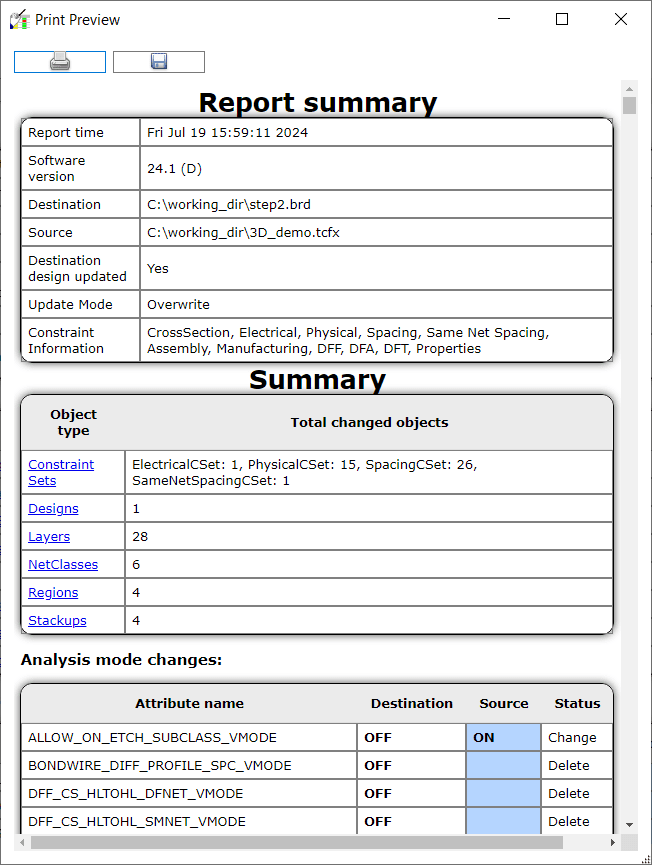
- Click the Print Icon and specify the printer details for printing the report.
Saving Constraint Difference Report as a Single File
To save the complete report, do the following steps:
- Choose the Print Preview icon.
A single-page view is displayed for reviewing.
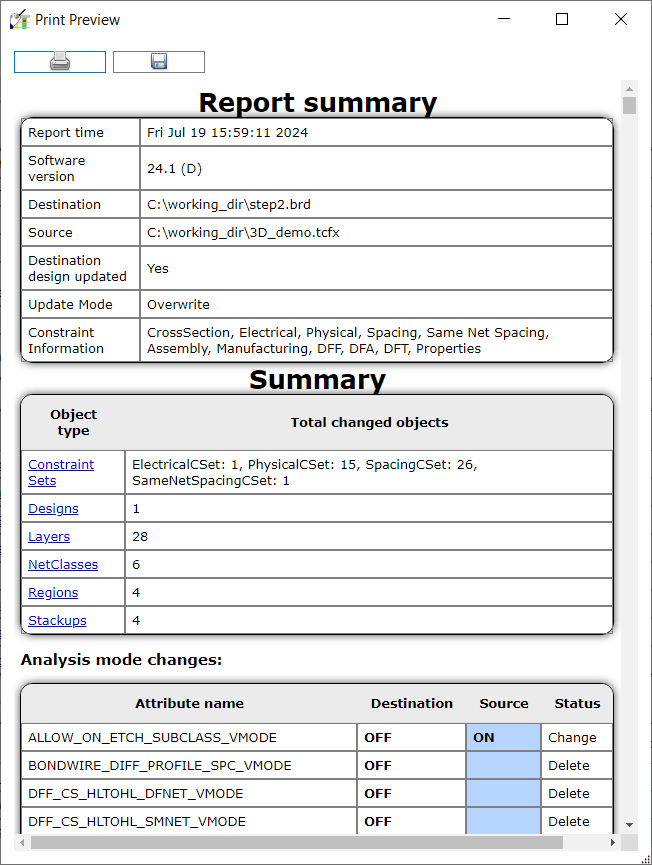
- In the Print Preview window, click the Export report to HTML icon.
The Export HTML File dialog box is displayed. - Browse the directory to save the report.
- Specify a name for the HTML file.
- Click the Save button.
A single-page report is generated that can be opened in any browser.
Viewing Constraint Difference Reports on Web Server
You can generate multiple reports and save them on a server that can be accessed anytime using a web browser.
To generate the constraints difference reports stored on a web server, set an environment variable CM_VDD_REPORT_URI_OVERRIDE. This variable provides a Uniform Resource Identifier (URI) to specify the path of the report directory. For example, http://<server_name>/VDD/report, where you can copy the VDD/report directory.
By default, the value of the variable is mapped to the path of report directory that exist in the installation directory, <installation_directory>\share\pcb\consmgr\VDD\report.
To view an XML version of the report in Firefox, disable URI and enter the following command in the system command window:
firefox -app <installation_directory>\share\pcb\consmgr\VDD\diff3rptViewer\diff3rptViewer.ini -file file://<path to rpt>.xmlWhen using Chrome, use the --allow-file-access-from-files option to view the XML file.
chrome --allow-file-access-from-files file://<path to rpt>.xmlThe XML file can be directly opened for viewing in the Internet browser.
Reports already saved on the disk can also be viewed using the XULRunner utility.
Interpreting Constraint Differences
The report viewer is a two-frame, tree-view based window.
Navigating the Report
You can navigate the report using the following modes:
| Navigation Mode | Function |
|---|---|
|
By Tree-view |
Shows a summary of the selected node in the tree-view. |
|
By following Links |
Shows a summary of an object when the object name link is selected. |
|
By previous and next selections |
Shows selections made forward and backward in the report viewer. |
The Constraint Difference report for a single layer is displayed in the following figure:
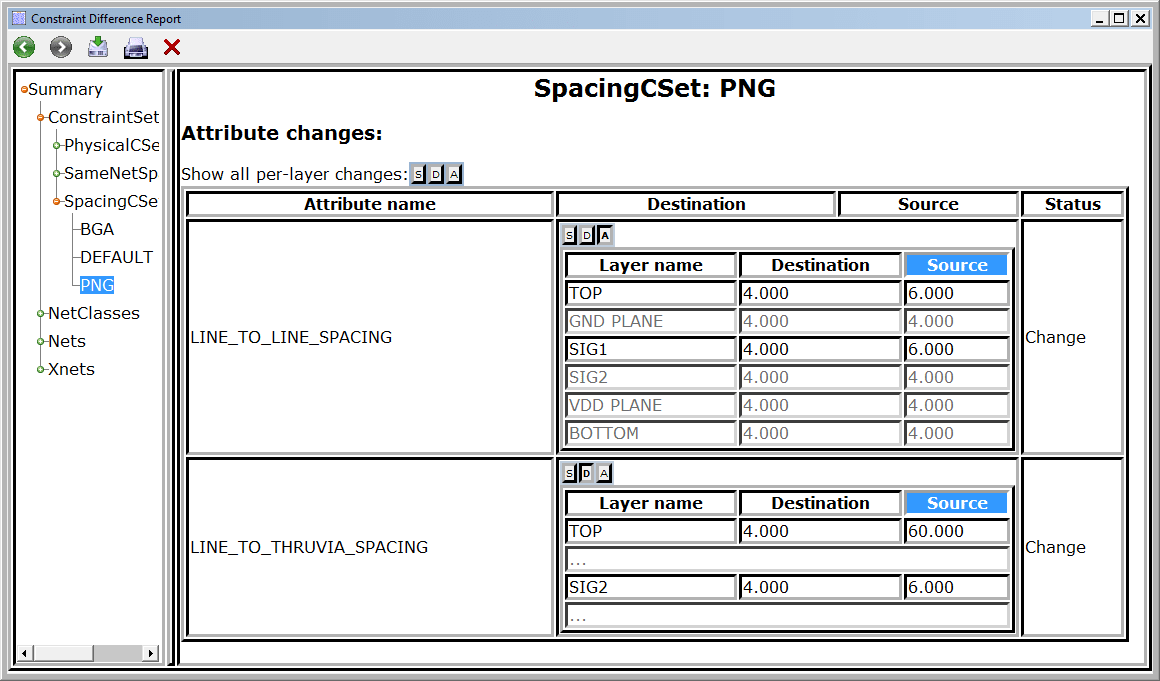
Viewing Modes
The following viewing modes are available in the viewer:
- Differences only (D): Shows differences only between destination and source constraints values.
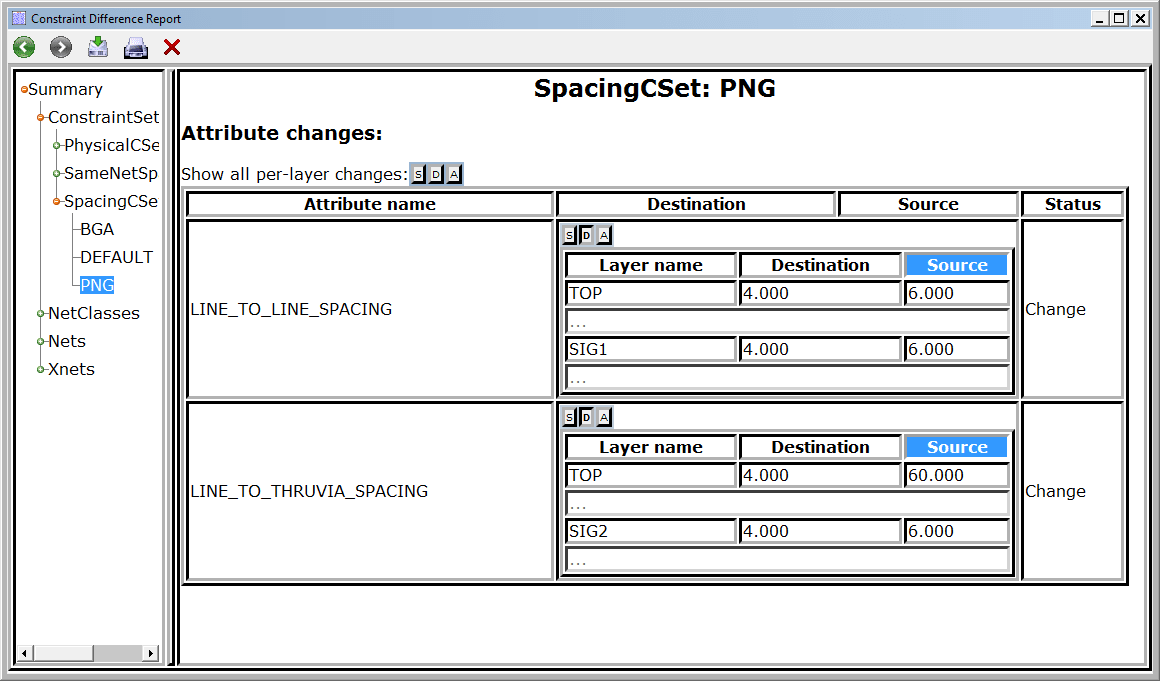
Unchanged layers are not reported.
- All values(A): Shows constraint values at destination and source for all layers.
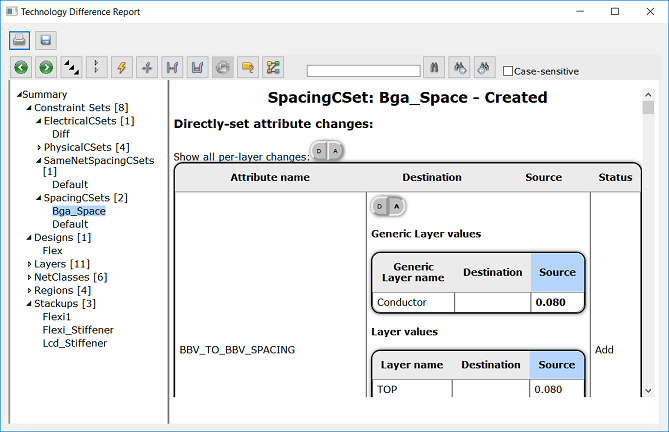
Customizing the Constraint Difference Report
You can modify the site-level flow configuration to tailor the behavior of constraint difference report.
- Open the consmgr folder located in your installation directory, <release>/share/local/consmgr.
- Open cds_flow_config.txt file.
- Edit the options within the cds_flow_config.txt file as per your requirements.
Following options are shown in the cds_flow_config.txt file.
| Options | Description | Condition | Default Value |
|---|---|---|---|
| Always generate report and preview differences | Constraint report are always generated to preview the differences before continuing. | While running F2B and B2F flow. | OFF |
| Simplified out-of-sync dialog | Reduce options on out-of-sync dialog for clear understanding. | While running F2B and B2F flow. | OFF |
| Use overwrite mode when out-of-sync | Use overwrite mode when schematic and layout are out-of-sync. Default is Changes-Only. |
While running F2B and B2F flow. | OFF |
| Report all differences | Constraint report will generate additional information including documents pending changes from the application being updated. Only applicable in Changes-Only mode. |
While running F2B and B2F flow. | OFF |
| Do not update cross section | When ON, do not update any cross-section data in layout. | While running the F2B flow only. | OFF |
| Overwrite property definitions | Overwrite existing user-defined property definitions in the design based on the definition in the SITE-level consmgr.wcfx. | While importing WCFX file. | OFF |
View the next document: 07 - Constraint Compiler
If you have any questions or comments about the OrCAD X platform, click on the link below.
Contact Us